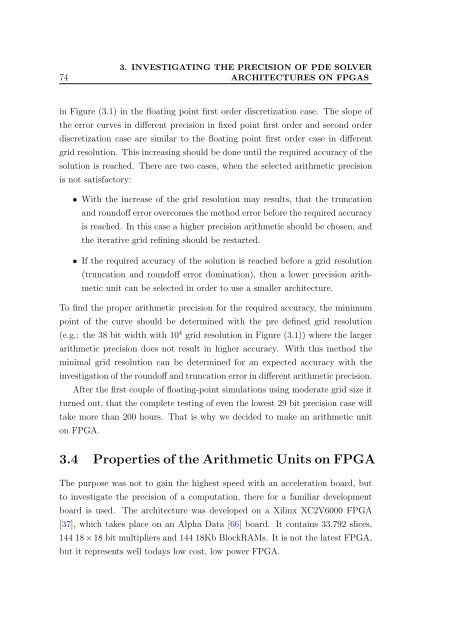PPKE ITK PhD and MPhil Thesis Classes
PPKE ITK PhD and MPhil Thesis Classes
PPKE ITK PhD and MPhil Thesis Classes
You also want an ePaper? Increase the reach of your titles
YUMPU automatically turns print PDFs into web optimized ePapers that Google loves.
74<br />
3. INVESTIGATING THE PRECISION OF PDE SOLVER<br />
ARCHITECTURES ON FPGAS<br />
in Figure (3.1) in the floating point first order discretization case. The slope of<br />
the error curves in different precision in fixed point first order <strong>and</strong> second order<br />
discretization case are similar to the floating point first order case in different<br />
grid resolution. This increasing should be done until the required accuracy of the<br />
solution is reached. There are two cases, when the selected arithmetic precision<br />
is not satisfactory:<br />
• With the increase of the grid resolution may results, that the truncation<br />
<strong>and</strong> roundoff error overcomes the method error before the required accuracy<br />
is reached. In this case a higher precision arithmetic should be chosen, <strong>and</strong><br />
the iterative grid refining should be restarted.<br />
• If the required accuracy of the solution is reached before a grid resolution<br />
(truncation <strong>and</strong> roundoff error domination), then a lower precision arithmetic<br />
unit can be selected in order to use a smaller architecture.<br />
To find the proper arithmetic precision for the required accuracy, the minimum<br />
point of the curve should be determined with the pre defined grid resolution<br />
(e.g.: the 38 bit width with 10 4 grid resolution in Figure (3.1)) where the larger<br />
arithmetic precision does not result in higher accuracy. With this method the<br />
minimal grid resolution can be determined for an expected accuracy with the<br />
investigation of the roundoff <strong>and</strong> truncation error in different arithmetic precision.<br />
After the first couple of floating-point simulations using moderate grid size it<br />
turned out, that the complete testing of even the lowest 29 bit precision case will<br />
take more than 200 hours. That is why we decided to make an arithmetic unit<br />
on FPGA.<br />
3.4 Properties of the Arithmetic Units on FPGA<br />
The purpose was not to gain the highest speed with an acceleration board, but<br />
to investigate the precision of a computation, there for a familiar development<br />
board is used. The architecture was developed on a Xilinx XC2V6000 FPGA<br />
[37], which takes place on an Alpha Data [66] board. It contains 33,792 slices,<br />
144 18 × 18 bit multipliers <strong>and</strong> 144 18Kb BlockRAMs. It is not the latest FPGA,<br />
but it represents well todays low cost, low power FPGA.






![optika tervezés [Kompatibilitási mód] - Ez itt...](https://img.yumpu.com/45881475/1/190x146/optika-tervezacs-kompatibilitasi-mad-ez-itt.jpg?quality=85)









